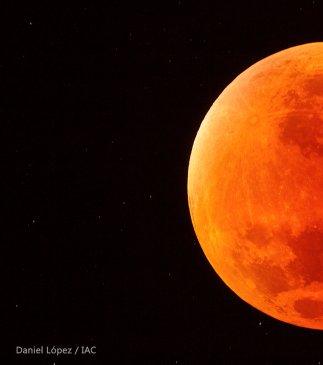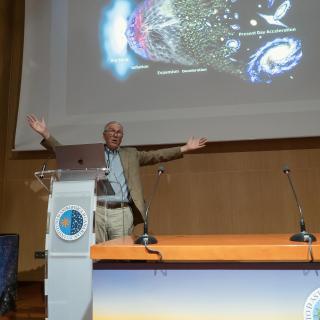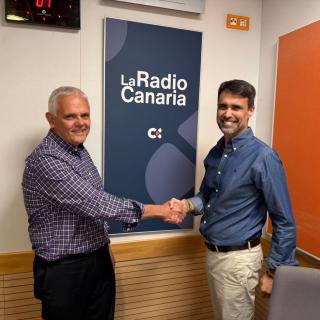The lunar eclipses occur when our satellite proceed by the Earth’s shadow. It does not happen every month, because the Moon’s orbit is inclined with respect to the Earth-Sun one (ecliptic). Unlike solar eclipses, lunar eclipses are visible from any place in the world, once the Moon is above the horizon during the time of the eclipse.
The 27th of July 2018, a total lunar eclipse will happen with the maximum centered to the Indian Ocean according to data provided by NASA. The phase of eclipse’s totality will last 1h 42m -the longuest of the XXIth century- starting at 7h30m pm UT (UT are acronyms in English for Universal Time; we have to add one hour more for having the local time in the Canary Islands and two hours in Continental Europe) and finishing at 9h13m pm UT. The Moon will start to eclipse -entrance in the terrestrial shadow- at 6h24m pm UT. From Oriental Africa one will be able to observe the eclipse in its totality. From Occidental Europe (Spain, Portugal, United-Kingdom, France or Italy) it will only be possible to observe the second part of the eclipse, with the Moon rising at the east horizon.
During the totality, the spectators will be able to verify/ check that the Moon doesn’t disappear of the sight but acquires a reddish tonality. The Earth’s atmosphere, which extends about 80 km beyond the diameter of our planet, acts as a lens that deflects sunlight. At the same time, it effectively filters its blue components and lets only the red light that will be reflected through the satélite. Thus, the Moon acquires the coppery glow so characteristic.
“After two years without total eclipses of the Moon in Europe on July 27, we will be able to see the Red Moon again. We must wait another six months to repeat the experience, in January 2019”, says Miquel Serra-Ricart, astronomer at the IAC.
Broadcast Live
There are several initiatives in which the IAC collaborates in order to broadcast in live the Luna eclipse. Part of the initiatives of Light Pollution Initiatives of the European Project STARS4ALL (stars4all.eu) and with the H.E.S.S (High Energy Stereoscopic System) cooperation and Hakos Astrofarm, the channel sky-live.tv will broadcast, in live, the Total Lunar Eclipse from Namibia. The appointement is the next Friday 27th of July at 6h 20 pm UT (7.20 local time in the Canary Islands, 8h 20m CEST, 8h 20m local time in Namibia).
“In the live from Namibia, the darkness produced by the eclipse will allow us to discover objects only visible from the southern skies, such as the Magellanic Clouds” explain Serra-Ricart, responsable for the Broadcast. Three Spanish Supercomputing centres will collaborate in the distribution of the webcast of the portal (sky-live.tv): the Extremadura Center of Advanced Technology (CETA-CIEMAT), the consorcio of University Servicies of Catalonia Center (CSUC) and the IAC. STARS4ALL is a Project financied by the H2020 Program of The European Union under the agreement number 688135. STARS4ALL is composed/formed of 8 institutions (UPM, CEFRIEL, SOTON, ECN, ESCP Europe, IAC, IGB, UCM) from 6 countries.
In addition, the Museum of Science and the Cosmos (MCC) has organised a night activity open to the public, called the "Festival of the Solar System", which includes observing the eclipse of the Moon and the planets Venus, Jupiter, Saturn and Mars with telescopes. This last planet, during the entire eclipse, will be the brightest celestial object in that part of the sky as it is the shortest distance from the Earth since 2003. "It will be curious to see the rivalry between the Moon and Mars as the protagonists of the night," says Alfred Rosenberg, astrophysicist at the IAC and responsible for the activity.
The event will begin at 9 pm in the Agustín de Betancourt square of the MCC. Through a camera in one of the telescopes, the eclipse will also be broadcast on the Facebook page of the Museums of Tenerife (https://www.facebook.com/museosdetenerife). "It will probably be one of the most observed lunar eclipses by the population -explains Rosenberg- taking place on a Friday early at night, in the summer period and accompanied by four of the brightest planets that can be observed with the naked eye; without a doubt, it is one of the most interesting astronomical events of the year.
Broadcast Channel:
- Youtube
Eclipse (imagen de la Luna y comentarios) https://youtu.be/l_6YuOgRbBc
SKYLIVETV: https://www.facebook.com/skylivetv
Museos de Tenerife: https://www.facebook.com/museosdetenerife
Contact:
Miquel Serra-Ricart: mserra [at] iac.es (mserra[at]iac[dot]es)
Alfred Rosenberg: alf [at] iac.es (alf[at]iac[dot]es) / arosenberg [at] museosdetenerife.org (arosenberg[at]museosdetenerife[dot]org)
More Information:
Web site of the STARS4ALL Project
MCC Cosmocrónicas: "Astronomical events summer 2018"




